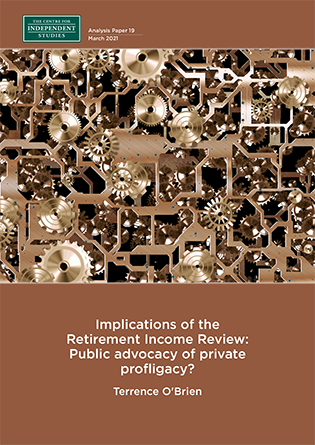The recent Retirement Income Review implies policies that would reduce after-tax returns to super saving, encourage faster spending of life savings and of equity in the family home, and minimise bequests. Its approach would incline each generation towards consuming more fully its own lifetime savings.
This paper demonstrates the Retirement Income Review relies on contested Treasury ‘tax expenditure’ estimates that use a hypothetical benchmark that is biased against all saving, but particularly against long-term saving.
Retirement Income Review implications
The AP reports that the effective tax rate on superannuation earnings is already much higher than the statutory rate. It also presents credible alternative Treasury measures that use a neutral benchmark. These estimate ‘tax expenditures’ that are only one-fifth the size the Retirement Income Review claims, essentially flat over time rather than rising strongly, and thus do not unduly favour self-funded retirees compared to Age Pensioners.
The Retirement Income Review implies policies should encourage faster and more complete consumption of superannuation capital and housing equity in retirement to prevent some retirees’ wealth rising and ending in bequests. But with savers’ equity in their houses typically about double their savings in superannuation, no prudent acceleration of super spending is likely to overtake inflation of housing prices in an era of fiscal and monetary stimulus and asset price inflation.
The Retirement Income Reviewproposes that a retirement income of 65-75% of the average of after-tax incomes in the last 10 years of work would be “adequate” for all, and estimates most (except some retiring as renters) are already saving more than enough for such a retirement. But it would be unwise and unnecessary for government to set its policies to constrain citizens’ choice of the self-funded living standards they want to work and save towards. Policies to crimp voluntary saving and accelerate retirement spending would create more uncertain retirements and a more fragile economy, more dependent on international lending and investment.
In Implications of the Retirement Income Review: Public advocacy of private profligacy? author Terrence O’Brien outlines that Treasury produces two estimates — one of $40 billion a year in ‘tax expenditures’ rising at 10% a year, and one of $7.5 billion a year, roughly steady over time.
“However, the RIR is heavily based only on the high estimate, while the more defensible estimate is the lower one,” O’Brien says. “The RIR expresses concern that the cost of ‘tax expenditures’ — driven by the concessional 15% tax on superannuation earnings — will grow to outweigh the actual cost of the Age Pension by the late 2040s. “The cost of superannuation tax concessions by the neutral measure of $7.5 billion a year is about one-fifth the claim the RIR uses.”
O’Brien says that by this measure, overall retirement system costs (super plus Age Pension) would likely not rise as a proportion of GDP, despite population aging and rising retirement incomes.
“Moreover, analysts have shown the effective tax rate on superannuation earnings is already much higher than the statutory rate and higher even than the RIR’s benchmark treatment. This is essentially because the tax wedge between what savers put aside while working and what they get back after retirement compounds over a lifetime. Lowering after-tax returns to saving as the RIR implies would reduce saving balances at retirement, just as higher administrative fees by super funds do.”
O’Brien says the methodology for the high estimate is biased against all saving, with the bias increasing with the length of the saving. “Based only on the biased estimate, the RIR suggests that the tax treatment of superannuation is too costly, growing too fast as a share of GDP, and too weighted to those who can afford to save up to the super contribution limits.
“In response, it implies policies that would limit compound after-tax returns to super saving and incline each generation towards consuming more fully its own lifetime savings. This is a remarkable inversion of the past 30 years of policy support for greater self-funding of retirement, through building household savings and through them, national savings,” he says.
O’Brien says the RIR also suggests government should aim to induce faster and more complete consumption of superannuation capital and housing equity to prevent retirees’ wealth rising and resulting in growing bequests. “The RIR apparently regards bequests as indicative of retirement policy failure. But with savers’ equity in housing typically about double their savings in superannuation, no prudent acceleration of super spending is likely to outweigh inflation of housing prices in an era of fiscal and monetary stimulus and asset price inflation,” he says.
The RIR claim that most are not drawing down their superannuation savings as fast as it would prefer is also based on a selective reading of the research it cites. “When the data properly includes elderly retirees who once had super balances but have completely exhausted them, spending of life savings is significantly higher than the RIR claims,” he says.
“While the RIR suggests most (except some retiring as renters) are already saving more than enough for a retirement that it considers ‘adequate’, it is unwise and unnecessary for government to set its policies to constrain citizens’ choice of the self-funded retirement living standards they want to work and save towards.
“Policies to crimp voluntary saving and accelerate retirement spending would create more uncertain retirements and a more fragile economy, more exposed once again to the vagaries of foreign lending and investment that preoccupied policy advisers in the early 1990s.
“Policies should be robust to uncertainties and shocks, as 2020 reminded us. The RIR’s policy preferences do not pass that test: bad health or economic shocks would drive retirees with more limited savings, spent faster, back onto taxpayer-funded support at a time Australia might least be able to afford it.”
SELECTED REFERENCES
- O’Brien, Terrence: Grandfathering Super Tax Increases, Spring 2016. Centre for Independent Studies, Policy, Vol 32 No 3, pp 3-12. Retrieved from https://www.google.com/url?sa=t&rct=j&q=&esrc=s&source=web&cd=&ved=2ahUKEwjKg7aBuIzvAhXS7HMBHS6TCw0QFjAAegQIARAD&url=https%3A%2F%2Fwww.aph.gov.au%2FDocumentStore.ashx%3Fid%3Dce9543f7-b6d7-4fec-8725-37d2e8a394c6%26subId%3D460590&usg=AOvVaw1K-z1FT8HRmJAiFs9DE7tE (Accessed 28 February 2921).
- Broadly speaking, the SG applies to all over 18 when then earn more than $450 gross in a month. See Australian Taxation Office: Working out if you have to pay super (7 October 2019). Retrieved at https://www.ato.gov.au/business/super-for-employers/working-out-if-you-have-to-pay-super/ . For scheduled SG rates, see also https://www.ato.gov.au/Rates/Key-superannuation-rates-and-thresholds/?page=24#Super_guarantee_percentage (Accessed 23 February 2021).
- Gruen, David and Soding, Leigh: Compulsory Superannuation and National Saving (1 July 2011). Retrieved from https://cdn.treasury.gov.au/uploads/sites/1/2017/06/CompulsorySuperannuationandNationalSaving.pdf (accessed 23 February 2021).
- Australian Government: A plan to simplify and streamline superannuation (9 May 2006; paper released with 2006-2007 Budget papers). Retrieved from https://archive.budget.gov.au/2006-07/index.html (Accessed 23 February 2021). In the previous tax arrangements, lump sum retirement benefits could previously have up to eight different components taxed in seven different ways.
- Cooper, Jeremy: A Super Charter: fewer changes, better outcomes. A report to the Treasurer and Minster Assisting Financial Services and Superannuation, (July 2013, pp 16-17). Retrieved from https://treasury.gov.au/sites/default/files/2019-09/p2013-390349-super_charter_report.pdf (Accessed 1 March 2021).
- Mill, John Stuart: Principles of Political Economy, Book V Chapter II ‘On the General Principles of Taxation’, (1878 edition). Retrieved from https://archive.org/details/politicaleconomy00milliala . (Accessed 23 February 2021).
- Simpkins, Sarah: Super assets rise to 175% of GDP (16 February 2021). Retrieved from https://www.investordaily.com.au/superannuation/48722-super-assets-rise-to-175-of-gdp (Accessed 23 February 2021).
- Callaghan, Michael; Ralston, Deborah; and Kay, Carolyn: Retirement income Review: Final Report (July 2020) p 73. Retrieved from https://treasury.gov.au/publication/p2020-100554 (Accessed 23 February 2021).
ALSO BY TERRENCE O’BRIEN











